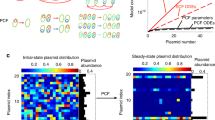Abstract
Bacteria abound with conjugative and nonconjugative plasmids that often carry genes determining a number of environmental adaptations. Plasmids may also encode genes that enable them to transmit themselves infectiously to new host cells, by conjugation or mobilization. The question of whether plasmids can be maintained in a bacterial community as parasitic DNA, that is, while conferring a selective disadvantage to their host, serves as a basic hypothesis in theoretical studies of the population biology of plasmids. The conditions necessary for the establishment and maintenance of plasmids have been determined analytically for the simplest possible models. Based on these a priori conditions, on some reconsiderations and extensions of these models, and on recent estimates of transfer rates of liquid and surface bacterial populations, it will be argued that within a bacterial population, a parasitic lifestyle is unlikely for most naturally occurring plasmids. This result raises anew the problem of how cryptic plasmids are maintained and why plasmids encode costly and elaborate genes for horizontal transfer.
Similar content being viewed by others
References
Achtman M, Kennedy N, Skurray R (1977) Cell-cell interactions in conjugatingEscherichia coli: Role of traT protein in surface exclusion. Proc Natl Acad Sci USA 74:5104–5108
Anderson ES (1968) The ecology of transferable drug resistance in the enterobacteria. Ann Rev Microb 22:131–180
Bouma JE, Lenski RE (1988) Evolution of a bacteria/plasmid association. Nature 335:351–352
Bradley DE, Taylor DE, Cohen DR (1980) Specification of surface mating systems among conjugative drug resistance plasmids inEscherichia coli K-12. J Bact 143:1466–1470
Brock TD (1971) Microbial growth rates in nature. Bacteriol Rev 35:39–58
Broda P (1979) Plasmids. Freeman, San Francisco
Campbell A (1981) Evolutionary significance of accessory DNA elements in bacteria. Ann Rev Microb 35:55–83
Caugant DA, Levin BR, Selander RK (1981) Genetic diversity and temporal variation in theE. coli of a human host. Genetics 98:476–490
Chan PT, Ohmori H, Tomizawa J, Lebowitz J (1985) Nucleotide sequence and gene organization of ColE1 DNA. J Biol Chem 260:8925–8935
Condit R, Levin BR (1990) The evolution of plasmids carrying multiple antibiotic resistance genes: The role of segregation, transposition, and homologous recombination. Am Nat 135: 573–596
Costerton JW, Cheng KJ, Geesey GG, Ladd TI, Nickel JC, Dasgupta M, Marrie TJ (1987) Bacterial biofilms in nature and disease. Ann Rev Microb 41:435–464
Cullum J, Collins JF, Broda P (1989) The spread of plasmids in model populations ofEscherichia coli K12. Plasmid 1:545–556
Curtiss R III, Caro LG, Allison DP, Stallions DR (1969) Early stages of conjugation inE. coli. J Bact 100:1091–1104
Dykhuizen D, Davies M (1980) An experimental model: Bacterial specialists and generalists competing in chemostats. Ecology 61:1213–1227
Eberhard WG (1989) Why do bacterial plasmids carry some genes and not others? Plasmid 21:167–174
Falkow S (1975) Infectious multiple drug resistance. Pion, London
Freter R, Freter RR, Brichner H (1983) Experimental and mathematical models ofEscherichia coli plasmid transfer in vitro and in vivo. Infect Immun 39:60–84
Gaffney D, Skurray R, Willetts NS (1983) Regulation of the F conjugation genes studied by hybridization andtra-lacZ fusion. J Mol Biol 168:103–122
Hartl DL, Medhora M, Green L, Dykhuizen DE (1986) The evolution of DNA sequences inEscherichia coli. Philosophical Transactions of the Royal Society, Serial B 312:191–204
Inselburg J, Ware P (1979) A complementation analysis of mobilization deficient mutants of the plasmid colE1. Mol Gen Genet 172:211–219
Ippen-Ihler K, Minkley EG Jr (1986) The conjugation system of F, the fertility factor ofEscherichia coli. Ann Rev Genet 20:593–624
Levin BR (1980) Conditions for the existence of R-plasmids in bacterial populations. In: Mitsuhashi S, Rosival L, Kremery V (eds) Fourth International Symposium on Antibiotic Resistance. Castle of Smolenice, Czechoslovakia, 1979, Springer-Verlag, New York, pp 197–202
Levin BR, Stewart FM, Rice VA (1979) The kinetics of conjugative plasmid transmission: Fit of a simple mass action model. Plasmid 2:247–260
Levin BR, Stewart FM (1980) The population biology of bacterial plasmids: A priori conditions for the existence of mobilizable nonconjugative factors. Genetics 94:425–443
Levin BR, Lenski RE (1983) Coevolution in bacteria and their viruses and plasmids. In: Futuyma J, Slatkin M (eds) Coevolution. Sinauer Associates, Sunderland, MA, pp 99–127
Lundquist PD, Levin BR (1986) Transitory derepression and the maintenance of conjugative plasmids. Genetics 113:483–497
Meynell GG (1973) Bacterial plasmids. MIT Press, Cambridge, MA
Novick RP (1987) Plasmid incompatibility. Microbiol Rev 51:381–395
Reanney D (1976) Extrachromosomal elements as possible agents of adaptation and development. Bacteriol Rev 40:552–590
Reeves P (1972) The bacteriocins. Springer-Verlag, Berlin, Heidelberg, New York
Simonsen L (1990) Dynamics of plasmid transfer on surfaces. J Gen Microbiol 136:1001–1007
Simonsen L, Gordon DM, Stewart F, Levin BR (1990) Estimating the rate of plasmid transfer: An end point method. J Gen Microbiol 136:2319–2325
Stewart FM, Levin BR (1977) The population biology of bacterial plasmids:A priori conditions for the existence of conjugationally transmitted factors. Genetics 87:209–228
Sukupolvi S, O'Connor D (1990) TraT lipoprotein, a plasmid-specified mediator of interactions between gram-negative bacteria and their environment. Microbiol Rev 54:331–341
Timmis KN, Andres I, Achtman M (1978) Fertility repression of F-like conjugative plasmids: Physical mapping of the R6-5 finO and finP cistrons and identification of the finO protein. Proc Natl Acad Sci USA 75:5836–5840
Willetts NS (1981) Sites and systems for conjugal DNA transfer in bacteria. In: Levy SB, Clowes RC, Koenig, EL (eds) Molecular biology, pathogenicity, and ecology of bacterial plasmids. Plenum Press, New York, London, pp 207–215
Willetts NS (1974) The kinetics of inhibition of Flac transfer by R100 inE. coli. Mol Gen Genet 129:123–130
Author information
Authors and Affiliations
Rights and permissions
About this article
Cite this article
Simonsen, L. The existence conditions for bacterial plasmids: Theory and reality. Microb Ecol 22, 187–205 (1991). https://doi.org/10.1007/BF02540223
Received:
Revised:
Issue Date:
DOI: https://doi.org/10.1007/BF02540223




